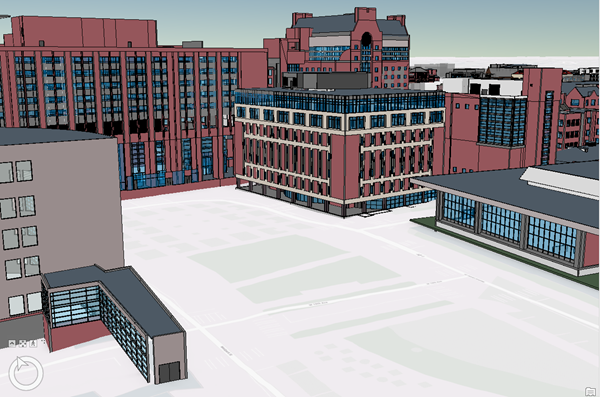A building layer allows your to represent building information modeling (BIM) data as a GIS data layer in ArcGIS Pro.
BIM elements in a GIS building layer contain the physical and logical characteristics of the BIM data. For example, a Building layer feature's geometry may depict a 3D chair, and its attributes contain the model, size, manufacturer, assembly code, and ID number as assigned in the BIM data.

A building layer created from a BIM file workspace in ArcGIS Pro is organized by disciplines and categories. A category is a collection of elements or systems that are used to model or document a building design that share the same use and set of defining attributes and correlates directly to an ArcGIS feature layer. For example, a BIM file can include architectural elements, such as doors and walls. The doors and walls are depicted as feature layers organized into the Architectural discpline layer of the building layer. These feature layers contain 3D geometries and have like sets of attributes.
All detailed information displayed in a building layer can be filtered to show only certain aspects of the building layer.
A building layer helps you utilize BIM information within GIS. For example, you can display a proposed building of a university campus together with geospatial information about the surrounding infrastructure and zoning to aid in understanding the impact of the new building. You can use exploratory analysis tools to examine lighting conditions or the interior of a building using the viewshed and slice tools.
You can combine multiple BIM models for one building or an entire campus and store it in a geodatabase using the BIM file to geodatabase tool. And then use the Make Building Layer geoprocessing tool to add the combined BIM data as a single building layer to represent a single complex building, or even multiple buildings as one building layer.
A building scene layer allows you to share and maintain information across the ArcGIS platform as web layer. For example, a building layer can be shared as a building scene layer and consumed in Scene Viewer .
Add a building layer from a BIM file using Catalog
You can add a BIM (Revit or IFC) data source directly to ArcGIS Pro to create a building layer.
- In the Catalog pane, right-click the BIM file.
- Select Add To Current Map.
A building layer is created.
Add a building layer from a BIM file using the Add Data ribbon button
You can add a BIM (Revit or IFC) data source directly to ArcGIS Pro to create a building layer using the Add Data button on the ribbon.
- Select the Add Data button on the ribbon.
- Browse to the BIM file on within the file system.
- Select the Ok button on the file dialog.
A building layer is created.
Add a building layer using the Make Building Layer tool
If you have 3D building information in a geodatabase, you can use the Make Building Layer geoprocessing tool to add a building layer to your scene. The input to the make building layer tool is a single geodatabase dataset of multipatch data, or a BIM file workspace.
- In the Geoprocessing pane, search for Make Building Layer.
- Select Make Building Layer to open the tool dialog box.
- Browse to the building data source and select it. Click OK.
This can be a geodatabase feature dataset with multipatch content, or a Revit, or IFC file.
- Enter a name for the building layer in the Output Layer.
- Click Run to run the tool.
A building layer is created and added to the scene. When adding geodatabase feature classes from a single feature dataset, the resulting building layer will be organized into construction discipline layers according to the same construction conventions applied to Revit or IFC data sources. Feature classes with unrecognized names will be added to the Architecture discipline layer by default.